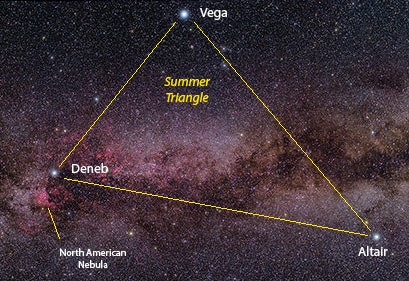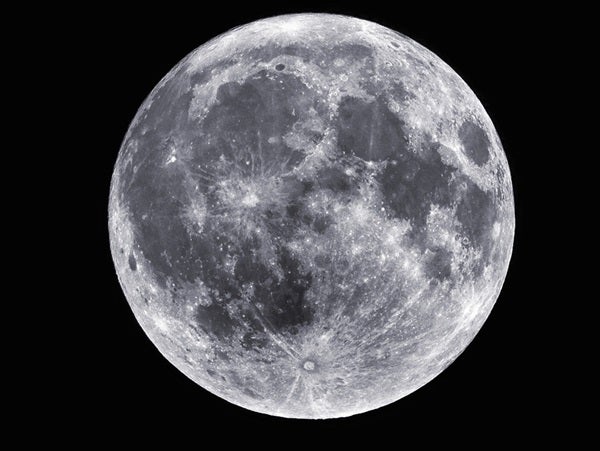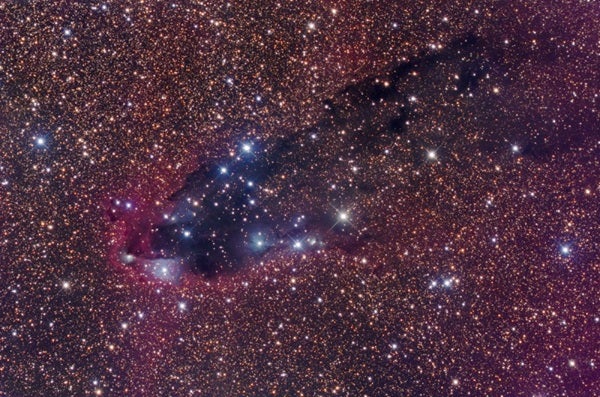Friday, July 15
- For observers in North America, the Moon appears 3° above Saturn this evening while the ruddy 1st-magnitude star Antares in Scorpius the Scorpion lies 10° below the Moon. The trio stands due south as night falls. Although Luna’s presence makes Saturn a little less impressive than usual, wait a few days for our satellite to leave the area. The ringed planet then appears conspicuous, shining at magnitude 0.2 among the fainter background stars of its host constellation, Ophiuchus the Serpent-bearer. When viewed through a telescope, the planet measures 18″ across while its dramatic ring system spans 41″ and tilts 26° to our line of sight.
Saturday, July 16
- If you like observing challenges, tonight is your night. Mercury passes just 0.5° (the diameter of a Full Moon) north of Venus in the early evening sky. From 40° north latitude, the two lie less than 4° high in the west-northwest 20 minutes after sunset. With a flat horizon and pristine skies, you might just glimpse the pair through binoculars. At magnitude –3.9, Venus will be the easier of the two to spot (Mercury glows at magnitude –1.0).
Sunday, July 17
- Perhaps no month better epitomizes summer in the Northern Hemisphere than July. And this month finds the season’s namesake asterism, the Summer Triangle, on prominent display. The trio’s brightest member, Vega in the constellation Lyra the Harp, stands nearly overhead shortly before midnight. The asterism’s second-brightest star, Altair in Aquila the Eagle, then lies more than halfway from the southeastern horizon to the zenith. Deneb, the luminary of Cygnus the Swan, marks the Summer Triangle’s third corner. Although it is the asterism’s dimmest star, it’s the brightest point of light in the northeastern sky.
Monday, July 18
- Brilliant Jupiter remains a beacon in the western sky after sunset. It appears nearly 20° high an hour after sunset and doesn’t dip below the horizon until nearly 11 p.m. local daylight time. Jupiter shines at magnitude –1.8 against the backdrop of southern Leo the Lion. The giant planet appears equally dazzling through a telescope, which reveals a wealth of atmospheric features on a disk that spans 33″.
Tuesday, July 19
- Full Moon arrives at 6:57 p.m. EDT. It rises in the eastern sky just as the Sun sets and reaches its peak in the south around 1 a.m. local daylight time. The Moon lies on the border between the constellations Sagittarius the Archer and Capricornus the Sea Goat.
Wednesday, July 20
- Look toward the south as darkness falls and you can’t help but see Mars. The Red Planet shines brilliantly at magnitude –1.0 — trailing only the Moon and Jupiter after dusk — against the much fainter background stars of Libra. And it remains visible until it dips below the southwestern horizon shortly after 1 a.m. local daylight time. When viewed through a telescope, Mars’ orange-red disk spans 14″ and shows a number of subtle dark markings. You also might glimpse the white north polar cap, which should be near its minimum extent now because summer ended in the planet’s northern hemisphere early this month.
Thursday, July 21
- Pluto reached opposition and peak visibility two weeks ago, and it remains a tempting target all night. It glows dimly at magnitude 14.1, however, so you’ll need an 8-inch or larger telescope with good optics to spot it visually. Pluto currently lies in northeastern Sagittarius, some 0.6° west-southwest of the 3rd-magnitude star Pi (p) Sagittarii. See “The quest for distant Pluto” in the July Astronomy for complete details on finding this world.
Friday, July 22
- Tonight offers a good opportunity for binocular users to track down one of summer’s finest open star clusters. NGC 6231 lies in the tail of Scorpius the Scorpion, just 0.5° north of the double star Zeta (z) Scorpii (which is another fine binocular sight). NGC 6231 shines at magnitude 2.6 and packs more than 100 stars into a region just 14′ in diameter. This part of Scorpius lies nearly due south after darkness falls, though it doesn’t climb high from mid-northern latitudes.
- For observers across most of eastern North America, the waning gibbous Moon crosses directly in front of Neptune tonight. The 8th-magnitude planet will be difficult to see even through a telescope when it passes behind the Moon’s lit limb, but significantly easier when it reappears from behind the dark limb. Because exact times depend on your specific location, set up your scope in early evening to be ready for the show.
Saturday, July 23
- The Southern Delta Aquarid meteor shower ramps up this week. The shower has a broad maximum in late July, but you should see a few members in the hours before dawn. Unfortunately, a waning gibbous Moon currently shares the morning sky, reducing the number of meteors you can see. To tell a Southern Delta Aquarid meteor from a random dust particle burning up in Earth’s atmosphere, trace the streak of light’s path backward. A shower meteor will appear to originate from the constellation Aquarius the Water-bearer.
Sunday, July 24
- If you didn’t have a chance to view Neptune passing behind the Moon on Friday, try tracking down the distant planet tonight when it passes 31′ (the width of a Full Moon) due south of the 4th-magnitude star Lambda (l) Aquarii. The pair rises shortly after 10 p.m. local daylight time and climbs some 40° above the southern horizon by the start of morning twilight. You’ll need binoculars to spy magnitude 7.8 Neptune and a telescope to see its blue-gray disk, which spans 2.3″.












